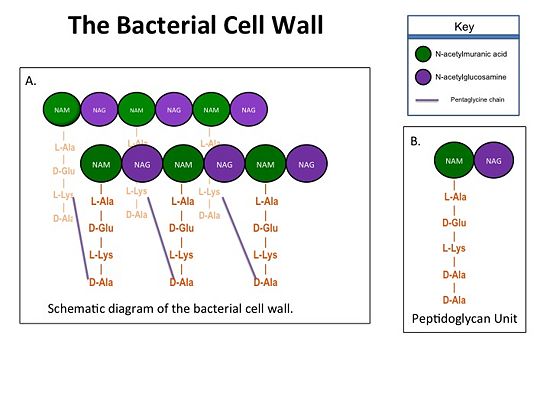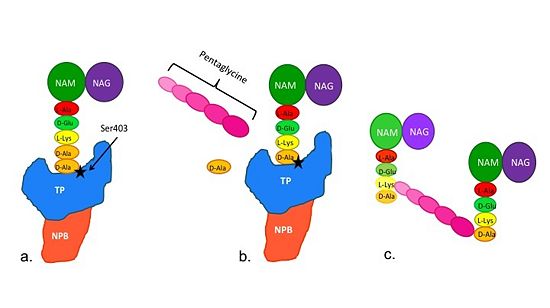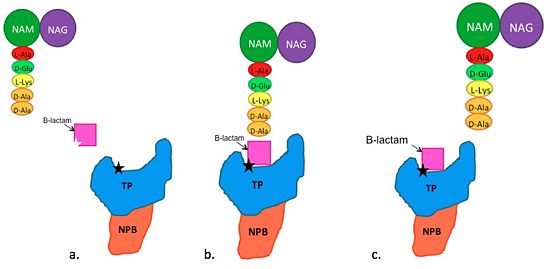Sandbox 128
From Proteopedia
(Difference between revisions)
| Line 28: | Line 28: | ||
==='''Structure of PBP2a, a B-Lactam Resistant Transpeptidase'''=== | ==='''Structure of PBP2a, a B-Lactam Resistant Transpeptidase'''=== | ||
| - | Isolates of methicillin-resistant S. aureus (MRSA) are resistant to almost all currently available B-lactams because they have acquired an alternative PBP, PBP2A (encoded by the mecA gene) that is neither bound nor inhibited by B-lactams. PBP2a is composed of two domains: a non-penicillin binding domain <scene name='37/372728/Npb_domain/1'>(NPB)</scene> and a <scene name='37/372728/Tp_domain/1'>TP</scene>-binding domain. The NBP domain of PBP2a is anchored in the cell membrane, while the TP domain residues in the periplasm with its active site facing the inner surface of the cell wall. The active site contains <scene name='37/372724/Serine403label/2'> a serine residue at position 403 (Ser403)</scene>, which catalyzes the cross-linking of the peptidoglycan rows with pentaglycine cross-links. | + | Isolates of methicillin-resistant S. aureus (MRSA) are resistant to almost all currently available B-lactams because they have acquired an alternative PBP, PBP2A (encoded by the mecA gene) that is neither bound nor inhibited by B-lactams. PBP2a is composed of two domains: <font color='orangered'><b>a non-penicillin binding domain </b><scene name='37/372728/Npb_domain/1'>(NPB)</scene></font> and a <font color='dodgerblue'><b>transpeptidase<scene name='37/372728/Tp_domain/1'>TP</scene>-binding domain. The NBP domain of PBP2a is anchored in the cell membrane, while the TP domain residues in the periplasm with its active site facing the inner surface of the cell wall. The active site contains <scene name='37/372724/Serine403label/2'> a serine residue at position 403 (Ser403)</scene>, which catalyzes the cross-linking of the peptidoglycan rows with pentaglycine cross-links. |
| Line 35: | Line 35: | ||
<scene name='37/372728/Tyr446_met641_interaction/4'>Tyr446 and Met641, and increase the association of ceftobiprole with PBP2a</scene>. | <scene name='37/372728/Tyr446_met641_interaction/4'>Tyr446 and Met641, and increase the association of ceftobiprole with PBP2a</scene>. | ||
As such, ceftobiprole is (shown as colors of the atom types [[CPK]]) is able to more efficiently react with Ser403 and therefore inhibit the activity of PBP2a. | As such, ceftobiprole is (shown as colors of the atom types [[CPK]]) is able to more efficiently react with Ser403 and therefore inhibit the activity of PBP2a. | ||
| + | |||
| + | |||
| + | =='''PBP2a and Ceftaroline'''== | ||
| + | |||
| + | <scene name='36/365380/3zfz_1/19'>PBP2a in complex with Ceftaroline</scene> (PDB:3ZFZ) | ||
| + | |||
| + | In addition to TP domain of PBP2a, there is an allosteric domain,highlighted orange, in which the distance between <scene name='36/365380/3zfz_1/20'>the active site and the allosteric site</scene> is 60Å. | ||
| + | |||
| + | Allosteric site serves as a binding site for the substrate <scene name='36/365380/3zfz_1/25'>peptidoglycan</scene>. When the substrate binds to the <scene name='36/365380/3zfz_1/21'>allosteric site</scene> (Tyr105, Asn146, Asp295, Tyr297), a conformational change occurs at the active site, opening it and allowing catalytic action to occur. | ||
| + | |||
| + | The medicine, <scene name='36/365380/3zfz_1/24'>ceftaroline</scene>, mimics the substrate at the allosteric site opening the active site, allowing <scene name='36/365380/3zfz_1/22'>ceftaroline</scene> to <scene name='36/365380/3zfz_1/23'>enter and bind noncovalently</scene>. | ||
Revision as of 21:13, 12 May 2014
| |||||||||||



